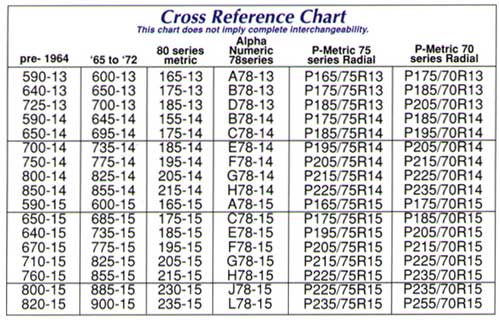Those of you begging for this type of content in the game, do not TL;DR this post....Tire sizes have changed drastically in America over the past 50 years. I don't know about the rest of the world, however. In 1975 a tire may have measured 305mm, but it wasn't a number used. Of course, the rest of the world except the US has been using a metric system for eternity, so Europe/Asia may well have had this type of sizing standard for eternity as well. Of course, those were the days of bias-ply tires for vehicles. Radials (or steel-belted radials as they were initially called) did not exist, or were still very new and not seeing heavy use anywhere in the world.
From my recollection, the 80-series and 78-series (middle columns) started seeing standard usage in the late 60s and continued into the late 70s/early 80s in the US. These were bias-ply tires. Passenger cars adopted the P-Metric system a bit earlier than trucks did, as radial tires became pretty common on passenger cars long before they were thought of for use on light/heavy trucks. Finding smooth transitions from these early sizes to modern metrics is a challenge, to say the least. They're not really "comparable". It is also worthy of noting these ancient bias-ply tires are still road legal (in the US at least) and for sale as you will see below.
Some of you might not know what I mean by "bias-ply tires", so here is a listing of tires for cars made before the radial tires of the 1980s:
https://www.universaltire.com/firestone-tires/firestone-vintage-bias-ply-tires.htmlTake note of what the tire sizing looks like.
Here is a listing specifically for bias-ply truck tires:
http://www.stausaonline.com/product-category/light-truck-tires/Finally, here is a cross-reference chart for bias-ply tires to use newer P-Metric tires. They are NOT perfect matches, but similar enough to keep you out of trouble.

- http://www.turbinecar.com/misc/Tire_Chart.jpg
- Tire_Chart.jpg (43.38 KiB) Viewed 2866 times
If you're really interested,
here is information on what a bias-ply tire is, and why they are different from today's radial tires.
Automation takes a very liberal, simplistic view concerning tires, and for good reason. Switching between these is complicated and not really necessary for a game. It is, however, a part of the real world. Keep this in mind when you beg for more "realism" in the game, as complexity of automotive engineering might be a lot more than you'd really like to see. As the old adage goes, be careful what you wish for.







